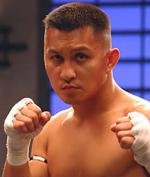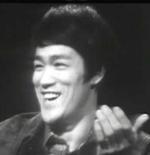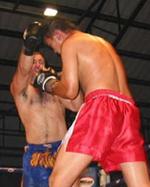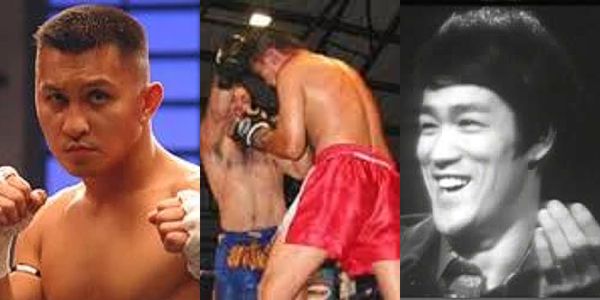Traditional Martial Arts Versus Reality Fighting
Back in the 1970s when I began kickboxing, I had to explain to people what that sport was. They couldn’t grasp the concept of boxing which included kicks. I remember my father’s friend telling me, “You can’t kick in a boxing match! They are going to disqualify you.”
Chuck Norris was being hailed as an innovator because he combined two, very similar, Korean martial arts, and used some street fighting and weapons in his movies.
We have come a long way, baby!

In Korea, where I am currently training, I flip on the TV and see two hugely-muscled men in a boxing ring. They shin-kick each other in the thighs. They use knees, elbows, clinch, and toss. Their punches come in combinations. Is it K-1? Is it Muay Thai? Is it MMA? Is it Pancrase? Is it Vale Tudo? If the referee steps in the second they hit the ground, you can eliminate about half those choices. Beyond that, the differences between all of the modern fighting arts are becoming smaller and smaller.
Pancrase doesn’t allow closed-hand strikes. Hybrid wrestling, a popular professional sport in Asia, allows strikes but prefers submissions. In Taiwan and Hong Kong they sometimes use a 20-second ground-fighting rule, to keep the action going. In Korea, amateur MMA fighters under the age of 18 wear boxing gloves, but still manage to win by both submissions and knockouts.
The obvious reason for the similarity between so many modern professional fighting arts is that the athletes, particularly the Americans, were extremely mobile. They went to various countries, fought different kinds of fighters, and adopted the techniques that worked, and threw out the others. In the 1970s, American kickboxing was essentially karate or Tae Kwan Do kicks, combined with punches. In the 1980s a competent professional boxer, with minimal or no kicking skill, could win against the average kickboxer. Few people had heard of cross training yet, and most martial artists used their martial arts training sessions as their cardio, strength, stretching, and technique training.
In the 1970s, I remember a huge debate about whether or not martial artists should lift weights. The general consensus was that they shouldn’t, because they would lose their flexibility. There was also a silly idea that strength and size didn’t matter in martial arts. Although everyone was in agreement on this point, judo, boxing, and wrestling had weight classes. Isn’t that proof that size and strength matter?
One of my favorite quotes about reality fighting is from my hero, UFC pioneer Ken Shamrock: “This is a sport where strength matters, but technique matters more.”

A side note to all of this is that Bruce Lee, before 1973, advocated weight lifting, running, and cross training. He was probably the first person to recognize western wrestling and boxing as martial arts. He used ground fighting and submissions. He saw that western fencers had the fastest most powerful lunge strike in the world, and emulated it. We all idealized Bruce. Most schools had a picture of him hanging up somewhere. But apparently no one listened to him, because they kept doing what they had done for thousands of years.
In the 1980s I fought countless challenge matches in the USA, and later in Germany, against all sorts of people with black belts in this or that. They could all kick better than me. But I generally won, strictly on punching, cardio and strength.

In Thailand I walked into a Muay Thai gym and challenged one of the guys to a western boxing match. Not only did he box well, but he beat me. In his corner was a Russian coach, shouting commands in broken English. He was imported to the gym on his reputation, having trained Olympic boxers in the former Soviet Union. In modern gyms, from Bangkok to Tokyo to Seoul to Hong Kong to New York, fighters are learning their hand techniques from boxing coaches. They learn their kicks from Thais. They have a separate strength coach and an endurance coach. Today, a one-dimensional boxer – no matter how good he is – wouldn’t last very long in a ring with a kickboxer.
Still in Korea, I switched to another channel, where guys in starched white uniforms were flipping through the air, breaking boards with their feet. I’ve been in the ring with champion Tae Kwan Do and other traditional martial artists, and I knew from experience that one solid punch in the face would change everything these guys believed about themselves and their art.
So, the question that entered my head again, for the one-millionth time: How can these two systems, traditional martial arts and reality fighting, exist in the same world? Why don’t the traditional arts just adopt newer and better techniques? Why do we still have more than one martial art?
In my mind, fighting is fighting. In the early days of UFC I remember a commentator saying, “To hell with all of these styles! You either punch, kick, or seize.”
If the goal is to have the most effective fighting system, it seems you would just adopt the best techniques from what everyone else is doing. And if everyone did this, we would develop into a world with one extremely effective martial art. But somehow, the traditional martial arts don’t do this.
My fortieth birthday is coming up in less than a week, and I am still following the same path I began at age eleven. I am looking for answers in martial arts. I began training as a child because my loud mouth and proud attitude – combined with my strong opinions – made me a target for bullies and street fights. I got beat up every single day at school. To make things worse, I was only 4′ 11″ when I entered high school. As an adult, I only stand 5 feet 7 inches (174 cm) but I weigh over 200 pounds (94 kg). My first martial arts teacher, H. David Collins in Tennessee, taught me kung fu and kickboxing. An innovator, he had us running, doing pushups and doing full-on boxing. He was a rebel. He didn’t make us wear uniforms. We didn’t bow. There was no foreign flag hanging on the wall. One of his techniques that raised eyebrows was that he had us doing a group exercise routine, set to music. This concept would later be called aerobics. But at that time, this was a crazy concept. Martial arts schools were supposed to be quiet temple-like places, where exercises were counted in Korean or Japanese.
I learned to fight, and won the big showdown with the bully at school. After that, my focus shifted. I was not training to defend myself or to street fight. I was training to challenge myself, to improve myself, to master the art of fighting. Later, when I began traveling, I found that martial arts was a way of experiencing foreign cultures. I trained in China, Thailand, Cambodia, Taiwan, Hong Kong, and Korea. Martial arts became a door that allowed me to enter a foreign culture.
In more than 25 years of training and competing in countless challenge matches and a number of professional fights, I have never earned any type of belt in martial arts. My martial arts articles run in magazines around the world. My book, The Monk from Brooklyn, about my studies at Shaolin Temple, is available at amazon.com. I have movies on DVD, and beginning in late 2006 I will be hosting a martial arts TV show called “Martial Arts Odyssey.” So, I obviously love martial arts. But I have never been able to practice any kind of traditional art long enough to earn a belt. Every few years I get the urge to do TMA. I show up in a school, train a couple days. Then either I get impatient and want to fight, or if it is in a country where I am known, they are curious and invite me to fight. Inevitably, they fight like my sister, and I am disappointed. I leave, running straight back to boxing or Muay Thai (Khmer Boxing). Why would I waste my time unlearning the fighting skills it has taken me years to develop?
In Korea, it happened the same way. On my second night of training, the teacher said he wanted me to fight one of his guys so they could see what I could do. They were curious about the way a boxer/kickboxer fights, and I think I may have only been the second foreigner to ever enter the school, so there is always some interest in seeing how foreigners do things.
I started looking around for boxing gloves, but they told me I wasn’t allowed to punch, because it wouldn’t be fair, and someone could get hurt. While I agree with them, having me fight without gloves wouldn’t demonstrate what it is that I do. I am, admittedly, the world’s worst kicker, so this was going to be a one-sided fight. When the teacher said, “Go!” I rushed in and crowded my Korean opponent. I stayed right on top of him, where he couldn’t use those long high kicks that they love. From this position, the only kick I could manage was a shin kick to the back of his right thigh, which I threw repeatedly. First he stopped to complain that I was crowding him. Next, he complained about the shin kicks. A few times, he did manage to get a little distance and throw high kicks, but I blocked with my elbows. Finally, one of my elbows landed square on his shin, and he collapsed in pain. The fight was over.
I pretty much knew the fight would go like that. How could they not have known? They watch K-1, Choi Hong-Man lives in our town, Busan, and practices Sirum (wrestling) across the street. How did they not know what kickboxing looks like? The next day when I came to class, the teacher complimented me on my performance the night before. He said that blocking kicks with elbows was deadly. He was also fascinated to watch me work the heavy bag with my hands. “Wow!” he said, or the Korean equivalent. “That is amazing, and tough.” Then he proceeded to teach me some stupid, silly, traditional martial art punching drill, after which, he taught me how to block kicks with my open hands.
After seeing that fight and seeing the bag work, did he still believe the way he had been doing it his whole life was better? If he didn’t believe it, then why didn’t he change?
When I started training in kickboxing again in the ’90s after an eight-year layoff, things had changed. Fighters were using Thai kicks, rather than karate or Tae Kwan Do kicks. The first time I saw the damage a shin kick could do, I immediately changed my style, and tried to learn the new technique. When I saw how a kickboxer could wear a man down by thigh kicking him, I adopted that style. When I began training with my pro-boxing coach in Cambodia, he told me to stop turning my fist over on the hook. He showed me once that it was faster and better to hold the fist in natural position, rather than to twist. And in one day, we undid a style I had been using my whole life.
Using the same logic, why don’t traditional martial arts just throw away the chop, the hammer strike, the finger spear, the monkey-brain, the slapping open-hand kick-block, or at least stop throwing their hands down when they kick? Why don’t they see that none of these techniques work, and that they should stop practicing them?
Proponents of traditional martial arts say, “It’s not about fighting. It’s about discipline.” Now I am training for a fight again. I am in the gym three hours a day. Are they saying pro-fighters lack discipline? They argue that traditional martial arts is about technique. Isn’t pro-fighting also about technique? The final argument is usually, “You just don’t understand. It’s not about fighting.”
If it’s not about fighting, then they need to change the name to the NON-MARTIAL ARTS.
This time, I didn’t quit Kuk Sul Won. And there is a chance I will stick with it and earn a belt. So, as much as I hate traditional martial arts, I am somehow drawn to it. Why?
Forty years old, and I still haven’t figured it all out.



